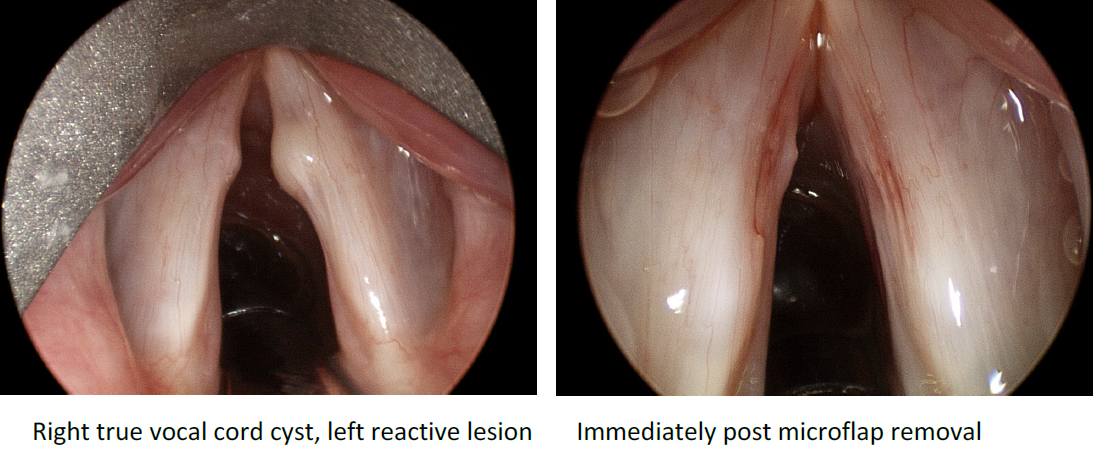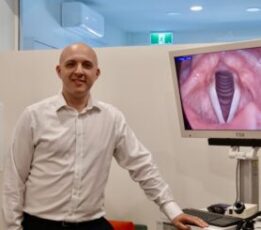Vocal Fold Cysts
Definition:
A vocal fold cystisa unilateral (on one vocal fold), benign (not cancerous) fluid filled sac or swelling under the surfacelayer of the vocal fold. There are two types of vocal fold cyst:Mucous retention cysts:occur due to a blocked mucous gland within the vocal fold. Epidermoid cysts:form due to a buildup of epithelium trapped below the surface layer of the vocal fold

Vocal fold cyst –removed under General anaestheticusing medial micro-lap
Causes
The cause of vocal fold cysts is unknown, however research suggests that trauma. This may include using the voice in a strained way, yelling, speaking over background noise for long periods of time or singing in a less than efficient way. Some cysts canalso be congenital, meaning that a patient is born with them, though they may not become symptomatic until some years later.
Diagnosis:
On clinical history, hoarseness with a reduced pitch range is the most common symptomof a cyst.In addition, the sensation of a foreign body at the level of the vocal folds, or a feeling of wanting to clear the throat or coughis common.
Cystscan be detected via mirror laryngoscopy or nasendoscopy under normal light, however diagnosis can be difficult without stroboscopy.
A stroboscopic evaluation gives us an idea of the vibratory characteristics of the vocal folds, which allows for greater sensitivity in diagnosis. A cyst and an accompanying reactive swelling can often appear similar to ‘vocal fold nodules’, which require very different management/treatment to a cyst. Correct diagnosis is paramount to appropriate management and successful rehabilitation of the voice.
Management:
Most commonly, a cyst must be removed surgically. Microlaryngoscopy surgery is usually a straightforward day procedure.Your ENT Surgeon and Speech Pathologist will discuss the surgery with you further.
Because incomplete removal may lead to recurrence, every effort must be made to remove the cyst intact. At the same time, the overlying mucosa must be preserved and draped over the area where the cyst was removed to minimize the chance of scar. This type of surgery is technically challenging, since the cyst, which is usually fragile, may be attached to surrounding tissue and is likely to burst or leak if not handled very gently.

The physician must decide how much of a role chronic irritation and phono trauma play in each individual patient and prescribe medication and voice therapy accordingly.
Initial Recommendations:
Trial 24 to 36 hours of complete voice rest (no whisperingor voice production of any type).Commence voice therapy with a speech pathologist.
Address singing voice use as well if a singer
Discuss with the diagnosing specialist whether short-term use of cortisone is indicated (not the preferred first option but may be indicated if there is evidence of secondary vocal fold inflammation).
Review the diagnosis if there is no progress preferably by undergoing videostroboscopy to determine whether there is an underlying cystor another lesion such as a polyp.
Review the size and severity of the cyst after voice therapy to determine whether the problem has been remediated without the need for surgical intervention.







